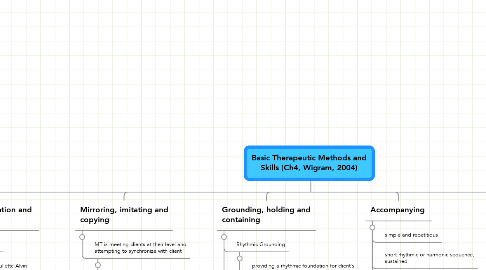
1. Accompanying
1.1. simple and repetitious
1.2. short rhythmic or harmonic sequence, sustained
1.3. provides continuous stability regardless of client's music
1.4. be sensitive to pauses or small developments in client's music
2. Dialoguing
2.1. Ways to promote dialoguing
2.1.1. Interjecting: waiting for space in client's music and filling gap
2.1.2. Making spaces: leaving spaces in MT's improv for client to interject
2.1.3. communicating through dialog may need to be modeled by MT
2.2. Musical cues
2.2.1. Harmonic cues
2.2.2. Rhythmic cues
2.2.3. Melodic cues
2.2.4. Dynamic and timbre cues
2.3. Gestural cues
2.3.1. physical cues
2.3.1.1. the power of conducting, of expressing one's experience of the music through physical gestures
2.4. Phrasing, interrupting, pausing and talking at the same time
2.5. Continuous 'free floating'dialogues
2.5.1. MT echoes and responds to client who plays continuously--many voices at once, operatic style
3. Mirroring, imitating and copying
3.1. MT is meeting clients at their level and attempting to synchronize with client
3.1.1. Can be powerful affirmation for client
3.1.2. Can be confronting to client and off-putting
3.1.3. Approach should be used appropriately
4. Matching
4.1. Improvising music compatible with client's style
4.2. Not identical, but clearly fits together at certain points
4.3. An equal, complimentary style of playing together
4.4. Matching exercises
5. Empathic improvisation and reflecting
5.1. Empathic improvisation
5.1.1. Frst applied by Juliette Alvin
5.1.1.1. Improv complemented client's way of being
5.2. MT is playing back what client is feeling
5.3. Reflecting
5.3.1. Matching moods, attitudes, feelings exhibited by client
5.3.2. Focus on reflecting mood, rather than matching music
6. Grounding, holding and containing
6.1. Rhythmic Grounding
6.1.1. providing a rhythmic foundation for client's improvisation
6.2. Tonal Grounding
6.2.1. establish tonal bass as anchor
6.2.2. provide octave, fifth or harmonic chord to support client's improvisation
6.3. Harmonic Grounding
6.3.1. providing secure musical grounding for client
6.4. Combined tonal and rhythmic grounding
6.4.1. providing secure musical grounding for client
6.5. Holding and containing
6.5.1. providing musical anchor
